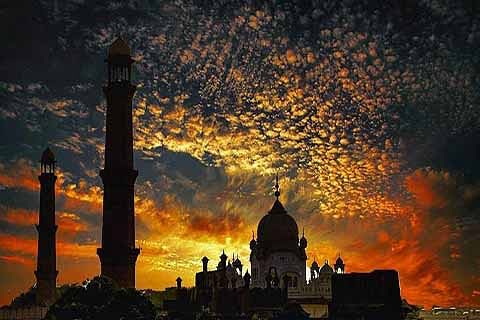Following Yarmouk—the decisive battle on Roman front,Byzantines didn’t have the nerve or the verve to engage the victorious Islamicforces in another major battle. Romans and Persians held the central stageglobally for over a millennium. Their battle gear, the armed formations were inessence defence oriented. The offence would only be attempted, as and when theenemy lines would be wearied down sufficiently. Offence had to be as risk freeas possible. Arabs on the contrary, even is pre-Islamic times would enter abattle head on. Islamic battle formation streamlined offensive tendencies, sonatural to Arabs. More important, the coordinated offence acted as a forcemultiplier. Islamic forces lesser in number thus assumed a potency that Romans and Iraniansfound very hard to combat. They tended to avoid death, Islamic forces embracedit. Death and destructions thus stalked Romans and Iranians. Nevertheless, itwas no slam bang affair, definite strategy was evolved by Caliph—Hazrat OmarFarooq (RA) at General Headquarters (GHQ) in Medina, by battle hardenedgenius—Saifulah Khalid Ibn Waleed and by administrative work out of Hazrat AbuObadiah Ibn Al-Jarah (RA) the commander at the Roman front. From Yarmouk, thebattlefront moved to Al-Quds.
Al-Quds is sacred to Jews and Christians, to Muslims aswell, being their Qibla-e-Awal. The Patriarch of Jerusalem sued for peace, witha rider. The willingness to surrender was subjected to presence of CaliphHazrat Omar Farooq (RA). The historical setting carries some deft touches, verymuch relevant to present day scenario in Al-Quds. The Commander of Muslimforces, Hazrat Abu Obadiah Ibn Al-Jarah (RA) could easily have overlooked therider and entered Al-Quds. He did not, the reason is not far enough to fetch.Like the modern day occupants of Al-Quds right from David Ben Gurion to ManheimBegin, Moshe Dayan, Golda Meir, Ariel Sharon and Netanyahu included, Muslimsnever wanted blood to be shed in the holy premises. The present occupants don’tshirk or shudder to shed it.
Hazrat Abu Obadiah Ibn Al-Jarah (RA) dispatched SOS to theCaliph in Medina to be present in person to accept surrender. The Caliph sawthe wisdom that the suggestion entailed and left the capital to care of HazratAli [RA]. The travel to Syria of the Caliph forms an important chapter ofIslamic lore. The Caliph left without a guard or fanfare. No trumpet wassounded, nor did the sirens wail. One wonders, what was his escort? Simplicity,events seem to suggest. Traveling like any other Bedouins [man of the desert]nothing suggested that he could be the Caliph. He and his attendant rode the horseback, believe it or not, by turns,relate some accounts. While as Ameer Ali in his ‘History of Saracens’ mentionsonly one attendant accompanying him , Shubli Nomani’s account talks of fewMahajarin [Meccan migrants] and few Ansars [Medinite helpers].
As he neared Jabiah, Syedena Omar Farooq [RA] witnessedMuslim commanders waiting to receive him dressed in silks of finest loom,relates Shubli Nomani. The Caliph flew into rage. Down he jumped from his horseand pelted pebbles at his commanders for trading simplicity with glamour. Hewas pacified only when they showed the cuirasses [steel armour] beneath thesilk robes, indicating battle readiness. On climbing a hillock, he saw charmingfields and towering edifices of Damascus. He was moved to say “They have leftmany a garden, fountain, park, arbour and riches, which they used to enjoy.Thus it is that we put a late generation in possession thereof”. All thisindicates and there are other instances to suggest that the great Caliph wasapt to put a question mark on what the surfeit of riches do to a society. Thesoftening effect makes mouse of men, the resultant is the decay and theultimate rout. History is full of what Syedena Omar Farooq (RA) meant to say.
Jabiah is where the peace treaty was signed, says Tabari,Ameer Ali concurs. Baladhuri and Azdi differ and quote Jerusalem as the venue.Whatever the venue, what matters is the content. Christians were accorded freeexercise of religion and allowed keeping their churches. Only light taxationwas imposed. Following the signing of treaty, Hazrat Omar Farooq left forJerusalem. Sophronius, the patriarch received him. On a tour of holy sites, itgot to prayer time. Syedena Omar (RA) refused to pray inside the ‘Church ofResurrection’ opting to pray on the steps of ‘Church of Constantine’. He toldthe Patriarch, were he to pray inside the Church, revered by Christians, on alater day Muslims might be tempted to claim the site as holy, on the plea oftheir Amer-ul-Momineen having prayed there. It shows how conscious was SyedenaOmar (RA) of his station and status and how keen was the foresight. His prayercould have developed into a bone of contention and he was keen to avoid such aneventuality. Whoever talks of the Muslims and the sword?! Has ever a conquerorin history been as humble, as benevolent as Syedena Omar Farooq (RA)? In factthere was no victor or vanquished, the attempt, the quest, the craving was fordissemination of a universal massage of brotherhood, peace and amity amongstnations.
While in Al-Quds, one day, at the stroke of a prayer,Syedena Omar (RA) asked Hazrat Bilal (RA) to break his self imposed ban on Azanfollowing departure of Prophet (PBUH) to his heavenly abode and call thefaithful to prayer. Hazrat Bilal (RA) made an exception. The Suhaba-e-Ikram(Illahi Rahma) wept unabashedly, remembering the times, when the greatest everborn, Prophet Mohammad (PBUH) welded men of the most mismanaged societalcombination in history–the pre-Islamic Arabs into the finest ever combinationof men. The formation thus was fast filling the geopolitical space beingyielded by great powers of past. History has never seen such a miracle.
Yaar Zinda, Sohbat Baqi [Reunion is subordinate to survival]






